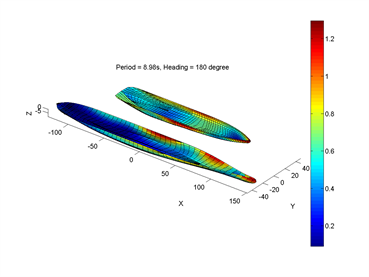 Ninety percent of the global trade moves by sea and more than $4 trillion worth of cargo is transported annually on large container ships. As commercial shipping continues to strengthen our economy, naval architects are faced with a naturally-occurring phenomenon in container ships previously seen in small fishing vessels—large amplitude rolling motion.
Ninety percent of the global trade moves by sea and more than $4 trillion worth of cargo is transported annually on large container ships. As commercial shipping continues to strengthen our economy, naval architects are faced with a naturally-occurring phenomenon in container ships previously seen in small fishing vessels—large amplitude rolling motion.
Large amplitude rolling motion makes large container ships extremely unstable and vulnerable to crew and cargo accidents, machinery failure, structural damage and possibly capsizing.
Large amplitude rolling due to parametric excitation occurs when the length of the wave is comparable to the ship length leading to especially pronounced variations in stability of the ship as it sails through rough seas. The ship is alternately pushed from side to side, and—in only a few cycles, elevated waves with rolling angles of more than 35 degrees are formed—making it dangerous for the crew and the cargo.
“The motion of a ship or offshore structure in waves has always been a fascinating problem for the naval architect,” said Dr. Jeffrey Falzarano, professor in the Department of Ocean Engineering at Texas A&M University.
Falzarano, a naval architect by training, has been studying the phenomenon in fishing vessels since his days as a graduate student.
“Large amplitude parametric rolling motion of container ships in head seas where the waves run directly against the course of a ship, however, is a relatively new problem,” he said. “It has posed severe concerns of ship stability.”
Falzarano, along with former student Dr. Amitava Guha and graduate students Dr. Abhilash Somayajula and Yujie Liu, has developed the Marine Dynamics Laboratory (MDL) Suite, a series of software programs that predict the probability of large amplitude rolling motion. Reducing the likelihood of an accident caused by the rolling is considered a more effective approach than mitigating the consequences. Supported by the Office of Naval Research’s Environmental Ship Motion Forecasting program, the group is helping develop the next generation roll motion prediction tools for naval architects.
“Much of the stability criteria for ship design currently fails to account for the dynamic motions of the ship,” said Somayajula. “The older criteria assume the waters are calm and so we need a new set of next generation stability rules based on the vessel’s dynamic response in realistic waves.”
According to the researchers, new and improved design and operation of container ships can effectively reduce the likelihood of large amplitude rolling motion occurring.
Falzarano and Guha developed MDL HydroD, a frequency-domain tool that analyzes interactions of waves and structures. The software program is a three-dimensional panel code that calculates first and second order wave loads and motion response at zero and forward speed in deep and shallow water.
Falzarano and Somayajula expanded on Guha’s work to develop SIMDYN, a time-domain tool that uses the frequency-domain results of MDL HydroD. The software program analyzes accurate models of the vessel’s motion in random waves. SIMDYN considers concepts such as nonlinear hydrostatics, nonlinear Froude Krylov forces and calculated roll damping to simulate the nonlinear and random vessel motions. Somayajula is currently applying this tool to analyze parametric roll of ships in irregular seas and solve the problem of optimization of ship design for safer, more stable and efficient vessels.
Falzarano and Liu’s research extends Guha’s MDL HydroD program to consider multiple vessels. It is designed to accurately evaluate the hydrodynamic responses of multiple floaters considering first and second order wave loads between multiple vessels, side by side offloading and analysis of wave elevation between the vessels.
“There is a tremendous amount of interaction between multiple ships of varying sizes because of the gap between them,” said Falzarano. “This is not well predicted well in the models and we need to analyze experimental data to improve the prediction.”
Researchers say, this potential flow software program addresses the need for a reliable tool seeking practical and cost-effective solutions in applications of offshore technology. There is a growing interest in understanding how vessels interact with large waves and with each other and seeking for a reliable and economically efficient analysis procedures.
To accurately predict rolling motion, Falzarano and his team analyzed the model test data taken from experiments conducted on R/V Melville, a general-purpose oceanographic research vessel operated by the University of California San Diego’s Scripps Institution of Oceanography.
The researchers are currently extending the MDL Suite of software programs to study steady wave resistance in a ship. The potential flow method is known for its efficiency and can used as an initial screening to identify promising candidates. These candidates can then be further analyzing using more sophisticated techniques such as computational fluid dynamics or model testing. This allows for the sequential use of these approaches in order to simultaneously optimize hull forms for motions and wave resistance.


(Left) Nonlinear Pressure Distribution on Container ship in waves; (Right) Amplitude of Linear Hydrodynamic Pressure over two US Navy Fast Transport Ships Side-By-side
Their next step includes using the MDL Suite to study other important problems such as offshore floating wind turbines and nonlinear wave loading.
“From fishing vessels and container ships to offshore floating wind turbines, we hope to make the oceans safer in general,” said Falzarano. “I have been fortunate to work with excellent research collaborators throughout my career, especially since coming to Texas A&M.”
Watch simulation of large amplitude rolling motion of a container ship and an offshore platform.